This site is made possible by its sponsors.
Please visit them!
T. - Abbreviation for tablespoon.
t. - Abbreviation for teaspoon.
tableau vivant - A scene presented by costumed actors who remain silent and motionless on a stage, as if in a picture.
(pr. tah-BLOH vee-vah)
Also see genre, history painting, narrative art, and performance art.
tablespoon - A unit of measure of both liquid and dry quantities equal to half an ounce (US, fluid), or to three teaspoons. To convert tablespoons to cups, multiply them by 0.0625. Abbreviated T.
tablet - A slab or plaque, as of stone or ivory, with a surface that is meant for or bears an inscription.
Example:
Mesopotamia, Assur, Neo-Assyrian period (714 BCE), Tablet of Sargon's 8th Campaign, baked clay, 37 x 24 cm, Louvre.
Also see panel.
![]()
tactile - Of or relating to the sense of touch.
tactile defensiveness - Strong aversion to textures, material, or even human touch. In art, common aversions include clay and paste.
Also see Individualized Education Program (IEP).

talent - An inherited or previously developed ability of significant quality for artistic or other achievement. One or more persons having such ability. What most people consider inherited abilities are more likely the result of nurturing experiences.
Talent is a wonderful blessing. Just as such child prodigies as Mozart excelled in music at a very young age, there are children who seem to take to drawing with greater facility than others. It is difficult to know to what extent a child's ability is inborn or the result of early experiences and encouragement. Certainly early experiences can affect a person's motivation. These in turn affect a person's willingness to seek knowledge independently, and to be more receptive to instruction. Regardless of different individuals' abilities, instruction can have an enormous impact on increasing any person's success in art.
It is a painfully common mistake to expect talent accompanied by little effort to result in great success. Curiously, however, there are many examples of motivated people, whose talent and circumstances were unremarkable, who have succeeded as artists. This is most likely for people who receive systematic instruction.
A person who is sufficiently motivated can achieve success with self-instruction, but examples of such people are rare. There are tremendous advantages to becoming involved with people who share (as good instructors do) the kinds of specialized knowledge artists find useful. Self-taught artists sometimes achieve recognition when they get the attentions of art writers and exhibitors, but typically their work is so extremely personal or derivative, and its audience limited to friends and relatives, that it disappears after the artist's death.
Quotations:
Also see art careers, art therapy, genius, heritage, inspiration, masterpiece, and virtuosity.
talisman - Something worn for its supposed magical benefit — warding off evil (apotropaic) or attracting good luck, perhaps. The word is derived from the Greek word telesma, meaning "rite." Whether made by or acquired by the wearer, talismans are said to be designed by experts in the various attributes of forms, colors and materials. They are typically medallions or pendants marked with cabalistic, medieval, or ancient signs, symbols, or texts. Some people understand that a talisman is an object that reminds a person to focus his own positive thinking in order to amplify his virtues, and that it has no powers on its own. Others believe that it has its own energies, and that the wearer's desires magnify them in some way that increase the wearer's ability to obtain a certain objective.
Examples:

A talisman of unidentified origin and meaning,
probably contemporary, apparently
gold, translucent
red and blue gems, and bone
or horn fragments.
This image shows it emanating a mysterious luminosity.
This jewel is analogous
to purportedly powerful objects in Hollywood's pseudo-archaeological
adventure stories, like the mummy and Indiana Jones movies.

This talisman is sold on the Web (in 2003),
described by a vendor as "To Attain Riches, double-sided and comes
with a 36-inch cord, accent bead and booklet. This talisman is
treasured by all who wish to become rich and famous! The talisman
for riches combined with the 'seal of prosperity' enables the
wearer to say and do the right thing at the right time. $25.00."
See medallion.
Also see amulet, anthropomorphism, charm, ex voto, fetish, milagro, and shaman.
tamping - Consolidating a fibrous or granular material such as resin-soaked glass fiber, concrete or damp sand by pressing or packing it into shape in a mold.
Tanagra - In ancient Greek art, a figurine of fired clay. Although these small-scale statues were first made in Athens and were soon being fabricated through out the Mediterranean world, they take their name from Tanagra, an ancient city in Boeotia, the region north of Attica, where great numbers were illicitly removed from tombs in the early 1870s. Tanagra sculptors were called coraplasters (in Greek, cora is a girl, plastein means to sculpt), as they were particularly drawn to representing women. Nearly all of the earlier figurines represented deities. The majority of Tanagras portray fashionable women or girls elegantly wrapped in thin himatia, often wearing large sun hats, and holding wreaths or fans. While most stand gracefully, some are seated or playing games. A number of boys are represented and Aphrodite and Eros appear as well. Many of these figurines have been discovered in private dwellings. Like other figurines found in houses, they probably had a religious purpose and were placed in domestic shrines. They were also dedicated in sanctuaries and placed in tombs. Up to a dozen statuettes were found in some graves at Tanagra.
Examples:

Greece, Figurine of Aphrodite Playing with Eros,
Tanagra, late 4th century BCE,
terra cotta, height
18.5 cm, State Hermitage Museum, St. Petersburg, Russia.

Greece, probably Boeotian, Standing draped female, Tanagra, late
4th-early 3rd century BCE,
Classical, terra cotta, height
6 7/16 inches (16.4 cm), Metropolitan Museum of Art, NY.
Also see ex voto.
tan-e - In Japanese art, a print with a dominant tone of orange-red.
Also see beni-e and nishiki-e.
T'ang or Tang - A Chinese dynasty that lasted 618-907 that was known for its prosperity along with the vigor of its visual arts and literature. (Don't miss the poets Li Po and Tu Fu!)
Examples of works from the T'ang dynasty:

China, Amphora (Ping) with Dragon Handles, early T'ang dynasty, about 618-700, ceramic, wheel-thrown stoneware with molded, modeled, and applied decoration and cream glaze, height 21 1/4 inches (53.98 cm), Los Angeles County Museum of Art.

China, Seated Buddha, T'ang dynasty (618-907),
c. 650, dry lacquer with traces
of gilt and polychrome
pigments, 38 x 27 inches
(96.5 x 68.6 cm), Metropolitan Museum of Art, NY. See Buddhist art.

China, Mirror, T'ang dynasty, late 7th or early
8th century, gilt bronze,
Worcester Art Museum, MA.

China, Pair of Lokapala, T'ang dynasty, c. 700-750,
earthenware with
sancai lead glazes, each 40
7/8 x 16 1/2 x 11 3/4 inches (103.8 x 41.9 x 29.8 cm), Dallas
Museum of Art. Lokapala are heavenly guardians. Sancai is a kind of three-colored lead-glazed pottery fired at low temperature. Its colors were most typically yellow, white, green, brown and blue. The sancai products of the T'ang Dynasty are mostly human figures, horses and camels.

China, Tomb Figurines of a Pair of Horses,T'ang Dynasty, 8th century,
earthenware with sancai lead glazes, white horse: height 71.2 cm,
length 82.5 cm; black horse:
height 70.0 cm, length 76.5 cm,
Kyoto National Museum.

Attributed to Han Gan (Chinese, active 742-756),
Night-Shining White, T'ang dynasty, 8th
century CE,
ink on paper,
12 1/8 x 13 3/8 inches (30.8 x 34 cm), Metropolitan Museum of
Art, NY. This is one of the most revered horse paintings in Chinese
art. This short scroll
displays a formidable provenance
in the form of chops of its
former owners. See attributed and equine art.
tang - A projection cast with a metal figure or tool with which the cast can be attached either to a base or to a handle. The tang may have been cast as a runner. Not to be confused with T'ang.
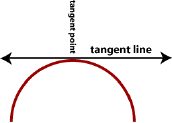
tangent, tangential - A tangent is a line, curve, or surface, touching but not intersecting another line, curve, or surface. Or, something is tangent or tangential when it makes contact with something else at a single point along its edge, touching but not intersecting its edge.
Also see align, angle, circle, ellipse, oval, and straight.
tanka - A Tibetan Buddhist painting on fabric, usually portraying the Buddha or lamas. Also spelled thangka.
Examples:

China, Khara-Khoto, Buddha in Vajrasana, late 11th-12th centuries,
gouache on cotton,
76 x 56 cm, Hermitage Museum, St. Petersburg, Russia.
Related link:
Burke Museum of Natural History, University of Washington, has a collection of tankas, many from the 20th century.
tapping - Cutting a thread inside a drilled hole so it will accept a screw or plug in which a corresponding thread has been cut. Tapping is done with a tap drill. The process is used to fill pin holes in a bronze cast with fine bronze rod.
tarashikomi - In Japanese art, a technique involving the use of wet pigments.
tartan - A decoratively woven fabric of a plaid pattern (sometimes called a sett) which is associated with a community in Scotland — a clan or family, a district, military, commercial, or other organization. There is a long history to a few of these associations, but only since the early 19th century did they become popularly synonymous with particular clans or families. Scotland has long been a major producer of wool. Local manufacturers produced cloth for local people, resulting in each district's acquiring a style eventually regarded as its own. When a clan dominated a region, whether in the highlands or the lowlands, a tartan became associated with the leading clan. From the Romantic period of the early 1800s, there has been tremendous interest in the study of tartans as they relate to Scottish traditions. Designs have proliferated in the last two hundred years, with families and organizations creating tartans that never had them before. Variants on older tartans have often been created because they are intended for use in specific circumstances, while hunting (earthier colors) or on formal occasions (brighter colors) for instance. New designs are often hybrids of old designs, lending the flavor of the district of their origin.
Examples:
![]()
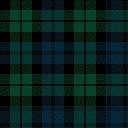
![]()
![]()
Black Watch, traditionally worn by military regiments raised in Scotland.
![]()
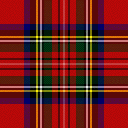
![]()
Royal Stewart
![]()

![]()
![]()
Caledonia
Related links:
See costume and Scottish art.
taste - A personal preference or liking. And, the capacity to tell what is aesthetically excellent or appropriate. Sometimes, the sense of what is proper, or least likely to give offense.
Quotes:
Also see aesthetics, bad art, banausic, brummagem, camp, chinoiserie, collection, deaccession, decoration, decorative, decorative arts, discrimination, Gemütlichkeit, gewgaw, hooptedoodle, kitsch, ornament, and popular culture.

tautology - Redundancy; needless repetition of the same meaning in what are merely different words.
(pr. taw-TAH-lə-jee)
tawny - Dark or dull yellowish brown.
Also see earth colors and neutral.

taxidermy - The craft or process of preparing, stuffing, and mounting the skins and other exterior parts of dead animals for exhibition in a lifelike state. A person who practices this craft is a taxidermist.
Anything entirely natural is generally regarded as other
than what we call art.
There is no subject, however,
more frequently chosen by artists
than nature, excepting the human figure
— itself a work of nature. There have been some examples of human
remains placed on display. Excepting acts of extreme cruelty and
war [often the same thing], parts of deceased humans are most
likely to be exhibited for
reasons of science or because
they're prized as carnival oddities rather than for reasons of
art. Taxidermy, therefor, brings up all sorts of ethical and legal
questions, along with aesthetic
ones, many having to do with the treatment of animals whose parts
are used. Among such questions: In what conditions did the animal
live and die? Did anyone cause it to suffer? If it was deliberately
killed, did this endanger the species, or otherwise upset the
ecosystem? Is this someone's attempt to transform
this creature into a trophy? There are many other questions, the
answers to which might be very disturbing. To be fair, some answers
may be reassuring. An animal can die of natural causes, for instance;
and the careful preservation of an animal's skin through taxidermy
can bring viewers to an increased
understanding of natural history, along with appreciation for
a species' beauty,
or ugliness, or its development
of camouflage, or its various
other qualities.
brings up all sorts of ethical and legal
questions, along with aesthetic
ones, many having to do with the treatment of animals whose parts
are used. Among such questions: In what conditions did the animal
live and die? Did anyone cause it to suffer? If it was deliberately
killed, did this endanger the species, or otherwise upset the
ecosystem? Is this someone's attempt to transform
this creature into a trophy? There are many other questions, the
answers to which might be very disturbing. To be fair, some answers
may be reassuring. An animal can die of natural causes, for instance;
and the careful preservation of an animal's skin through taxidermy
can bring viewers to an increased
understanding of natural history, along with appreciation for
a species' beauty,
or ugliness, or its development
of camouflage, or its various
other qualities.
Also see gyotaku, ivory, leather and fur, photorealism, tortoiseshell, and trompe l'oeil.
taxis - Greek for "arrangement, order." A rare term for the orderly division of a subject into its various components or attributes. "Eutaxic," also a rare term, means well arranged or well ordered. "Eutaxia" then, is good arrangement.
Quote:
Also see art history, Byzantine art, composition, expression, feng shui, icon, iconography, metonymy, modern, and taxonomy.
taxonomy - Division into ordered groups or categories. Of particular use to educators is Bloom's Taxonomy, a hierarchical list of thinking skills. The six levels of Bloom's taxonomy should be used in stating objectives of lessons and in devising questions which stimulate thinking at each level.
tchotchke - Showy but valueless. Rapidly trifling. One of the many words in English for "miscellaneous objects" or "nondescript junk," which also includes knickknack, trinket, doodad, whatnot, and gewgaw Tchotchke originated from the Yiddish tshatshke, and ultimately from a now-obsolete Polish word czaczko.
(pr. CHAHCH-kə or CHAHCH-kee)
Examples:
![]()

![]()
American?, Birdie, 20th century, cast
and glazed ceramic,
height 3 inches.
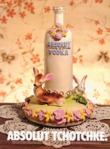
American, Absolut Tchochke, c. 2001, magazine advertisement for Absolut Vodka,
in which this brand's bottle has been transformed
into the sort of kitschy ceramic
ornament known as a tchochke.
Set before a sweetly flowered wallpaper,
and upon a circle of crocheted doilies,
this scene simulates a tableau
in the sort of home occupied by a little old lady of the last
century.
Also see bad art, bibelot, bric-a-brac, brummagem, camp, collectible, confection, decoration, decorative, decorative arts, hooptedoodle, kitsch, ornament, and taste.
tear sheet - A page torn from a magazine or some other publication printed on paper. As such, it might also be a found image, found material, or found object. Art students typically collect tear sheets for images of exemplars, or for images from or with which to work in art production — for components of collage, for example. Perhaps a graphic designer would speak of a tear sheet as a page bearing a graphic design which is seen in isolation from the publication for which it was intended. (If you have witnessed this, please describe your experience to this art lexicographer. - MRD)
See ephemera, reproduction, and visual culture.
teaspoon - A unit of measure of both liquid and dry quantities that is equal to a third of a tablespoon. To convert teaspoons to ounces (US, fluid), multiply by 0.16667. Abbreviated t. or tsp.
technique - Any method of working with art materials to produce an art object. Often implied is the sense that techniques are carefully studied, exacting, or traditional, but this is not necessarily the case.
Examples include basketry, blotting, carving, constructing, découpage, embossing, encaustic, exquisite corpse, firing, folding, hatching, kerning, laminating, marbling, modeling, necking.
Quote:
Also see additive, daho, feather, infrared reflectography (IR), manipulate, medium, openwork, process, and subtractive.
technology - The use of science, especially to achieve industrial, commercial, or engineering, as well as artistic results; or the particular scientific method and material used to achieve those results. "Technology" often refers to the essential qualities of a person's or society's tools, machines, or other apparatus used to achieve a mechanical end. In discussing art, technology might refer to complex machines used in the creation, exhibition, conservation, or study of art, such as potter's wheels, presses, cameras, projectors, computers, lasers, and video equipment.
Works in which technology is particularly important:
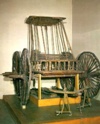
Russia, Eastern Altai, Pazyryk Burial Mound
5, Chariot, 5th-4th centuries BCE,
wood, leather, height
300 cm, diameter of wheels
150 cm, Hermitage Museum, St. Petersburg, Russia.

Sven Wingquist, designer, manufacturer: SKF
Industries, Inc., USA, Self-Aligning Ball Bearing, 1929, chrome-plated
steel, 1 3/4
x 8 1/2 inches (4.4 x 21.6 cm) diameter,
Museum of Modern Art, NY. MOMA's site says, "Good design
was considered by modernists as essential to the elevation of
society, and in 1934, this ball bearing was among the first works
to enter The Museum of Modern Art's design collection." See circle and design.

Ferdinand Porsche (German), designer, manufacturer:
Volkswagenwerk AG, Wolfsburg, Germany, Volkswagen Type 1 Sedan, designed 1938,
this one manufactured 1959, steel,
etc., 59 inches x 60 1/2 inches x 13 feet 4 inches (149.9 x 153.7
x 406.4 cm), Museum of Modern Art, NY.

Ralston Crawford (American, 1906-1978), Turbine Shafts, Coulee Dam #2, 1971,
oil on canvas,
20 x 30 inches, Kemper Museum of Contemporary Art, Kansas City,
MO. See Precisionism and vertical.
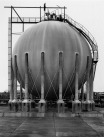
Bernd and Hilla Becher (German, 1931- and 1934-), Sphere, c. 1960s, black and white photograph of a large, steel storage tank. See photography and sphere.
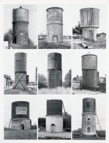
Bernhard Becher and Hilla Becher (German, 1931-, and 1934-), Water Towers (Cylindrical), 1978, composite of nine gelatin silver prints, Milwaukee Art Museum, WI.

Richard Rogers (Italian, 1933-) and Renzo
Piano (Italian, 1937-), Centre Pompidou, 1972-1976, high-tech
steel and glass
museum, with a massive cast
exoskeleton, and a staircase in a transparent
tube.

Sam Lucente (American, contemporary), manufacturer:
IBM, East Fishkill, NY, Diagram of Logic Chip and Corresponding Microchip,
1986, computer-generated plot on paper, silica, 44 x 45 1/2 inches
(111.8 x 115.5 cm), Museum of Modern Art, NY.
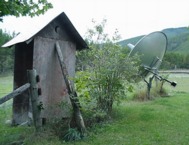
A contemporary
photograph
juxtaposing two levels of technological sophistication: a rustic privy and a satellite
dish. See incongruity.
About technology:
Also see design, digital imaging, Futurism, hygrothermograph, interdisciplinary, new media, pointing machine, Rube Goldberg, scanner, science and art, video, video digitizer, videodisc, and World Wide Web (WWW).
teleidoscope - A type of a kaleidoscope, a teleidoscope is a cylindrical optical instrument that is rotated so that when a person looks into it, the viewer sees a succession of radial designs produced by a carefully arranged set of mirrors reflecting constantly changing patterns made by mirrored images of a triangular section of whatever can bee seen through the other end of the instrument. The word teleidoscope is a hybrid of the words "telescope" and "kaleidoscope" — a kaleidoscope that turns whatever you point it toward into a radial pattern. Other kaleidoscopes multiply a view of small translucent objects (often bits of colored glass such as millefiori) in a chamber at one end of the cylinder. The first kaleidoscope was invented by David Brewster (Scottish, 1781-1868) in 1816.
Examples:
![]()

![]()
Jerry
Farnsworth (American, contemporary), a view through one of Farnsworth's teleidoscopes.
Related links:
Also see fish-eye lens, lens, mandala, projection, slide, and wide-angle lens.
teleology - The philosophical study of design or purpose in natural phenomena. The use of ultimate purpose or design as a means of explaining natural phenomena. Purposeful development, as in nature or history, toward a final end.
Also see empiricism, epistemology, interdisciplinary, metaphysics, ontology, and phenomenology.
telephoto, telephoto lens, telephoto shot - A telephoto lens is a camera lens system integrating a telescope. Its focal length is significantly greater than the focal length of a normal lens. For a 35 mm camera with a 24 by 36 mm format, a normal lens is 50 mm; a lens of focal length 70 mm or more is considered telephoto. Its view has or covers a field of vision (an angle of view) narrower (or "longer") than the normal lens, to any angle less than 35°. A zoom lens is in telephoto position when zoomed in, and wide-angle when zoomed out.
Telephoto is a photographic system using telephoto lenses to narrow a field of vision, producing a large photographic image of distant subjects, making the them appear to be nearer than they really are; or photography in which a telephoto lens is used.
The opposite of a telephoto lens is a wide-angle lens, and the opposite of a telephoto shot is a wide-angle shot.
Example:

Each of these three photos was taken of the same
woman, but each with a different lens — left: wide-angle,
center: normal, right: telephoto. Each of these frontal views was printed so that the eyes would be the same distance
apart. The subject is narrowest with the wide-angle lens, and
widest with the telephoto lens. Which photo is the best shot?
Also see blowup, bump up, cinema, cinematography, close-up, detail, and enlarge.
telescope, telescopic lens - A telescope is an optical device for viewing directly or photographically distant subjects by making them look larger and nearer. A telescope is usually cylindrical, gathering visible light by means of the refraction through a combination of lenses. These might include the reflection of light rays by a concave mirror. A telescopic lens system attached to a camera is usually called a telephoto lens.
Also see viewfinder.
temper - To bring to a desired consistency, texture, hardness, or other physical condition by or as if by blending, admixing, or kneading. Also, to harden or strengthen metal or glass by the application of heat, or by heating and cooling. Temper may also be used as a synonym for temper.
Also see temperature.
temperament - See artistic temperament and bias.
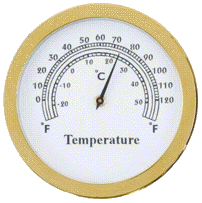
temperature - The intensity of heat as measured in degrees Fahrenheit or degrees Centigrade, also known as Celsius. (Chart for temperature conversions between Fahrenheit and Centigrade)
The regulation of the temperature of environments where artworks are made, exhibited, and stored is important in their conservation. Temperature is significant because it affects relative humidity. When moist air is heated, the relative humidity decreases; when it is cooled, the relative humidity increases. Temperature is also important because deterioration progresses much more quickly at higher temperatures than at lower ones. Exposure to heat can drastically accelerate the aging of organic materials and of many modern synthetics.
Controlling the temperature of various materials is important in the techniques used to manipulate them.
Temperatures of particular importance:
The temperatures of colors are often described as warm (purples, reds, oranges, and yellows), neutral (violets and greens), and cool (blue-greens and blues). The color temperature of light sources is usually measured in units kelvin (K).
About a thermometer:
A nurse with a thermometer behind her ear says, "Wait till I find the asshole who's got my pencil."
Also see alloy, climate control, flammable, hot glue, hot glue gun, hygrothermograph, lost-wax casting, measurement, metal, pyrometric cones (firing ceramics), science and art, and temperature conversions between Fahrenheit and Centigrade.
temperature key - The relative level of a color's temperature, whether referencing an individual color, or a color scheme seen either in an artwork's entirety or in a passage within one. The warmer the color, the higher the temperature key; the cooler the colors, the lower the temperature key.
Also see chroma key, contrast key, cool colors, tonal key, warm colors, and value key.
template - A pattern used as a guide in making a form with accuracy, as when using a stencil.
Examples:
![]()

![]()
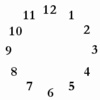
![]()
Clock face templates with Arabic and Roman numerals. See horology.
Also see compass rose, die, French curve and tracing.
temporal art - See performance art.
Ten American Painters or The American Ten or The Ten
tendentious - Marked by a strongly implied point of view. Also spelled tendencious.
Also see allegory, narrative art, and propaganda.
![]()

![]() tenon
- A projection often rectangular
in section on the end of a
piece of material (especially
in wood, but also used in stone
and metals). A tenon is made
to be fitted into a hollow, mortise,
or groove of equivalent size in order to create a joint.
tenon
- A projection often rectangular
in section on the end of a
piece of material (especially
in wood, but also used in stone
and metals). A tenon is made
to be fitted into a hollow, mortise,
or groove of equivalent size in order to create a joint.
Also see boss, convex, finial, join, and pendant.

tenon saw - A saw with a short, rectangular blade which is supported along the side opposite the cutting edge by a narrow metal grip. It is used for cutting with accuracy through small sections of wood.
tensile strength - The capability of a material to withstand the stress imposed upon it when it is stretched or extended. Rubber, nylon, and steel are materials noted for their varied capacities for tensile strength.
Also see ductile.
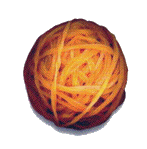
tension - A tenuous balance maintained in an object between opposing formal or allegorical forces or elements often causing anxiety (from dissonance to angst to pain) or excitement (from the simply interesting to the utterly sublime). It embodies what is sometimes called edginess or frisson; and bears comparison to unity, harmony, and variety.
Tension might be considered one of the principles of design.
Quote:

Also
see grotesque, incongruity, juxtaposition, rhythm, transformation, and weight.
terminal - In computer terminology, a device, often equipped with a keyboard and a monitor, through which information or data can enter or leave a computer system.
terra - In painting, earth from which pigment can be made, as in terra vert.
terra cotta or terracotta or terra-cotta
terra cruda - In contrast to terra cotta, unfired clay. The difference is also this: a piece of terra cruda is more brittle, more easily crumbled, and can dissolve into mud if exposed to water, while a piece of terra cotta is harder to break, and will never again dissolve into mud. Works in terra cruda are more acceptable than in terra cotta when they are expected to be impermanent (temporary), or if they were produced by very young children for whom permanency is likely to be unimportant, or if firing the clay is too likely to cause it to break up.
Adobe bricks can be either baked or not baked.
Examples:
Honoré Daumier (French, 1808-1879), François-Pierre-Guillaume Guizot, 1831, terra cruda bust painted with oil, 22 x 17 cm, Musée d'Orsay, Paris. See caricature and French art.

Honoré Daumier, Charles Philipon (1800-1861),
Journalist and Director of the Magazines Caricature
and Charivari, c.1833, terra cruda (unfired clay)
bust painted
with oil, Musée d'Orsay,
Paris, France. See many more of Daumier's clay caricatures at
ABC Gallery.
terra sigillata - Also called Samian pottery, terra sigillata is a Mediterranean ceramic ware decorated with relief figures, first produced about 300 BCE, having evolved from the Etruscan's black pottery called bucchero ware. "Terra sigillata" is Latin, literally meaning "stamped earth." It was fired in an oxidizing atmosphere. The finest examples of terra sigillata, known as Arretine ware, were made at what is now the Italian town of Arezzo.
Examples:

Roman Italy, Two Terra Sigillata Vases, mid 1st century
CE
- mid 3rd, red-orange slip.
See iron, oxide,
and vase.

Roman England?, Colchester Vase,
2nd-3rd century CE,
terra sigillata vase, Colchester, Museum. Detail: gladiators, victorious secutor and retiarius
who holds up finger to signal defeat. Detail: bestiarii with whips and dogs or wolves.
Detail: bestiarius
with sticks, stag in background.
tertiary colors - See intermediate colors.
tesselate - To form into a mosaic pattern, as by using small polygons of stone or glass.
Also see smalto, tesselation, tessera, and tile.
tessera - A small piece of glazed clay used in mosaics. The plural is tesserae.
Also see smalto.
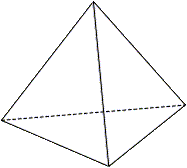
tetrahedron - A polyhedron
with four two-dimensional
faces, six edges,
and six vertices. It is the
simplest of all polyhedrons, and is a type of pyramid. The sides of a right tetrahedron 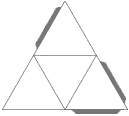 are identical equilateral triangles.
The regular tetrahedron is one of the five Platonic solids (along
with the hexahedron (cube),
octahedron, dodecahedron,
and icosahedron). The plural
form can be either tetrahedrons or tetrahedra. Here's a link to
an animated image of a tetrahedron.
are identical equilateral triangles.
The regular tetrahedron is one of the five Platonic solids (along
with the hexahedron (cube),
octahedron, dodecahedron,
and icosahedron). The plural
form can be either tetrahedrons or tetrahedra. Here's a link to
an animated image of a tetrahedron.
Also see mathematics, polygon, and vertex.
texture - An element of art, texture is the surface quality or "feel" of an object, its smoothness, roughness, softness, etc. Textures may be actual or simulated. Actual textures can be felt with the fingers, while simulated textures are suggested by an artist in the painting of different areas of a picture — often in representing drapery, metals, rocks, hair, etc. Words describing textures include: flat, smooth (third row, right), shiny, glossy, glittery, velvety, feathery, soft, wet, gooey, furry, sandy, leathery (second row, right), crackled (upper left), prickly, abrasive, rough (first row, right), furry, bumpy, corrugated (second row, left), puffy (second row, third), rusty (third row, second), and slimey (third row, third).
Examples of textures:
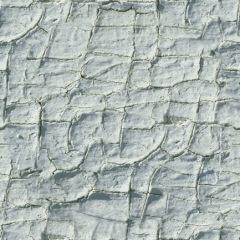

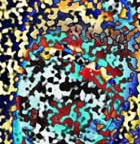

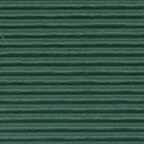
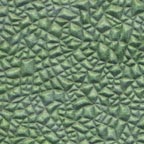
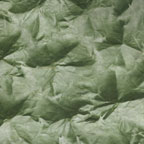
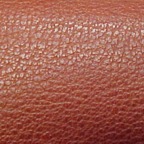
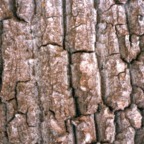
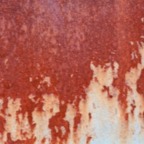


Examples of artworks in which textures are particularly important:
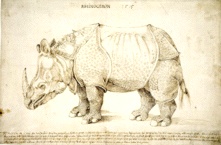
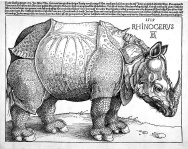
Albrecht Dürer (German, 1471-1528), The Rhinoceros, drawing and
woodcut, 1515, British Museum, London.
"Dürer produced this drawing and woodcut from reports of the arrival in Lisbon of an Indian rhinoceros in May of 1515. No rhinoceros had been seen in Europe for over 1000 years, so Dürer had to work solely from these reports. He covered the creature's legs with scales and the body with hard, patterned plates. Perhaps these features interpret lost sketches, or even the text, which states, '[The rhinoceros] has the color of a speckled tortoise and it is covered with thick scales'. So convincing was Dürer's fanciful creation that for the next 300 years European illustrators borrowed from his woodcut, even after they had seen living rhinoceroses without plates and scales." See nature and Northern Renaissance.
Other resources concerned with texture:
Also see haptic,
laid and wove
papers, marbling, moiré,
nail, nuance,
rugosity, tactile,
and textile.
What's this texture on your monitor?!

Has someone been spitting here or simply foaming at the mouth?!
https://inform.quest/_art